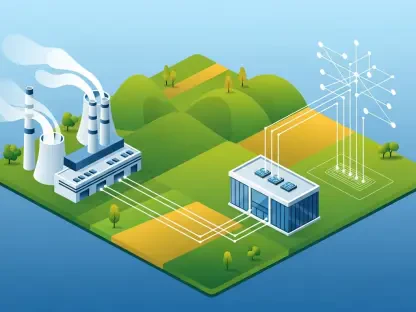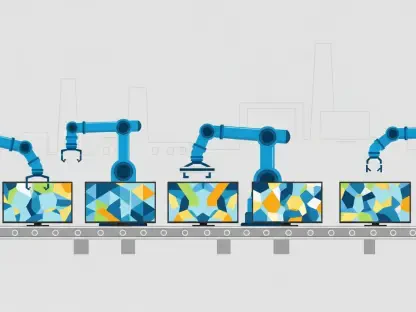In an era where high-speed internet has become as essential as electricity, millions of people in rural and suburban areas across the United States and around the globe are still grappling with the harsh reality of the digital divide. Fiber-optic technology, often celebrated as the pinnacle of connectivity for its unmatched speed and reliability, frequently fails to reach those who need it most due to exorbitant costs, complex logistical hurdles, and drawn-out permitting processes. From navigating rugged landscapes like mountain ranges to overcoming bureaucratic delays in securing rights-of-way, the barriers to fiber deployment leave countless communities disconnected, stifling economic opportunities and access to critical services like telehealth and online education. This persistent gap underscores a pressing need for innovative solutions that can deliver broadband swiftly and affordably.
Thankfully, a compelling alternative has emerged in the form of Fixed Wireless Access (FWA), a technology that sidesteps many of fiber’s physical and financial constraints. By transmitting high-capacity internet via radio signals over long distances, FWA eliminates the need for extensive infrastructure such as trenching or pole attachments, offering a lifeline to isolated regions. This approach is gaining momentum as a scalable and efficient complement to fiber, proving that a hybrid model of connectivity can transform the broadband landscape. With real-world applications already making waves, the integration of wireless solutions is poised to redefine how underserved areas gain access to the digital world.
Confronting Connectivity Challenges
Barriers to Fiber Deployment
The digital divide remains a stubborn challenge, particularly in rural and suburban parts of America where reliable internet access is often out of reach, impacting everything from education to economic growth. Fiber-optic networks, despite their reputation for superior performance, face significant obstacles that prevent widespread deployment. The costs of laying fiber are astronomical, especially in sparsely populated areas where return on investment is low. Additionally, challenging terrains—think rocky mountains or flood-prone zones—complicate installation, while regulatory hurdles like securing permits and navigating right-of-way disputes can stall projects for years. These barriers highlight a critical flaw in relying solely on fiber to close connectivity gaps, pushing the industry to explore alternative paths that can deliver results more efficiently.
Beyond the financial and geographical issues, the timeline for fiber deployment often leaves communities in limbo, unable to access essential online services. Rural schools struggle to provide digital learning resources, and small businesses miss out on e-commerce opportunities, widening the gap between connected urban centers and disconnected regions. Even when funding is available, the sheer complexity of coordinating large-scale fiber projects means that many areas remain underserved for far longer than acceptable. This ongoing struggle emphasizes the urgency of adopting technologies that can bypass these delays and bring high-speed internet to those who have waited long enough, ensuring that no region is left behind in the digital age.
The Persistent Digital Divide
While urban centers enjoy the benefits of robust internet infrastructure, rural and suburban communities often face a starkly different reality, with limited or no access to broadband. This disparity creates profound inequalities, as students in remote areas struggle with virtual learning, healthcare providers cannot offer telemedicine, and businesses lose competitive edge without reliable connectivity. Government initiatives have poured billions into addressing this issue over the years, yet the gap persists, largely because traditional solutions like fiber are not universally feasible. The digital divide is not just a technological problem but a social and economic one, demanding innovative approaches that can adapt to diverse local challenges.
Moreover, the digital divide disproportionately affects vulnerable populations, including low-income households and minority communities, who may lack the resources to advocate for better infrastructure. Even in suburban areas close to urban hubs, pockets of poor connectivity exist due to uneven investment and planning. The frustration of waiting for fiber to arrive, often delayed by bureaucratic red tape or logistical nightmares, compounds the issue, leaving residents feeling forgotten. As the world becomes increasingly digitized, the need for equitable access grows more urgent, pushing technology providers and policymakers to rethink strategies and prioritize solutions that can deliver immediate impact across varied landscapes.
The Rise of Fixed Wireless Access
Speed and Scalability of FWA
Fixed Wireless Access (FWA) emerges as a powerful solution to the connectivity crisis, offering a faster and more cost-effective alternative where fiber falls short. Unlike fiber, which demands extensive physical infrastructure, FWA leverages radio signals in both licensed and unlicensed spectrum to deliver high-capacity internet across vast distances. This eliminates the need for disruptive trenching or complex pole setups, making it particularly suitable for remote or rugged areas. By providing a reliable connection without the lengthy delays associated with traditional methods, FWA positions itself as a complementary technology, enhancing rather than replacing fiber in the broader quest for universal broadband coverage.
The scalability of FWA further cements its value in addressing diverse connectivity needs. Service providers can deploy wireless networks relatively quickly, connecting clusters of homes or businesses in rural settings without waiting for exhaustive fiber builds. This rapid rollout is especially critical in regions where time is of the essence, such as during disaster recovery or when supporting sudden surges in demand for remote work and learning. Supported by federal programs like the Broadband Equity, Access, and Deployment (BEAD) initiative, FWA enables a pragmatic approach to broadband expansion, ensuring that even the most isolated communities can tap into the digital economy without enduring prolonged disconnection.
Global Impact and Real-World Success
The global relevance of FWA is evident in transformative projects that showcase its potential to bridge connectivity gaps on a massive scale. In India, for example, the Broadband Wireless Access plan utilizes wireless backhaul and point-to-multipoint links to extend fiber networks, connecting millions of homes in areas where laying fiber is impractical. Such initiatives demonstrate how wireless technology can amplify the reach of existing infrastructure, delivering affordable internet to vast populations. These successes highlight FWA’s role as a force multiplier, capable of adapting to unique regional challenges while maintaining robust performance.
Closer to home, FWA is making significant strides in rural America, where service providers harness the technology to reach isolated communities efficiently. By aligning with federal efforts like the BEAD program, these deployments bypass the years-long wait for fiber infrastructure, providing immediate relief to areas desperate for connectivity. The ability of wireless solutions to integrate seamlessly with existing networks ensures that providers can maximize coverage without overhauling entire systems. This adaptability, proven across varied contexts from densely populated regions to remote outposts, underscores the technology’s capacity to address the digital divide on a meaningful scale.
Innovations Powering Wireless Solutions
Cutting-Edge Advances in FWA
Technological progress is propelling Fixed Wireless Access into a new era, narrowing the performance gap with fiber and making it a formidable option for broadband delivery. Innovations such as wideband operation, capable of handling up to 160 MHz, significantly boost data capacity, while enhanced non-line-of-sight capabilities ensure connectivity even in obstructed environments like dense forests or urban canyons. Additionally, AI-driven spectrum management tools optimize frequency usage, minimizing interference and maximizing reliability in crowded or challenging settings. These advancements transform FWA into a robust solution that can meet the rigorous demands of modern internet usage.
The impact of these breakthroughs extends beyond technical specifications, directly benefiting end users who rely on consistent, high-speed access. Improved performance means that rural households can stream educational content, participate in virtual meetings, or access telemedicine services without frustrating disruptions. As interference-heavy environments become less of a barrier, FWA proves its worth in diverse scenarios, from suburban neighborhoods to remote farmlands. This evolution reflects a broader industry trend toward smarter, more adaptive technologies, ensuring that wireless systems are not just a fallback but a strategic component of comprehensive broadband networks.
Tailored Solutions for Diverse Needs
Flexibility is a cornerstone of FWA’s growing prominence, with specialized equipment designed to address a wide array of connectivity challenges across different landscapes. Solutions encompassing access, backhaul, and client radios are engineered to function with minimal infrastructure, adapting seamlessly to urban, suburban, and rural settings. This versatility allows providers to customize deployments based on specific local conditions, whether connecting a small cluster of homes in a remote valley or supporting a bustling city district. Such tailored approaches ensure that wireless technology meets varied demands without compromising on quality or efficiency.
Moreover, the ability to operate across multiple topologies enhances FWA’s appeal as a practical tool for broadband expansion. In areas where traditional infrastructure is scarce, lightweight and adaptable wireless systems can be installed with relative ease, reducing both cost and time investments. This is particularly beneficial for regions with unique geographical or regulatory constraints, where a one-size-fits-all model would falter. By catering to the distinct needs of each environment, FWA not only fills immediate connectivity gaps but also lays the groundwork for scalable, long-term solutions that can evolve with changing technological and societal needs.
Shaping a Connected Tomorrow
The Power of Multi-Technology Strategies
Achieving universal broadband access hinges on embracing a multi-technology framework that combines the strengths of fiber and wireless solutions. Fiber remains the backbone for high-density, high-demand areas, delivering unmatched speed and capacity where population and infrastructure justify the investment. However, its limitations in cost, time, and geography necessitate the integration of FWA to cover gaps in rural and hard-to-reach regions. This hybrid model maximizes coverage by deploying fiber where feasible and wireless where urgency or practicality demands, ensuring that no community is overlooked in the push for inclusive connectivity.
This strategic blend offers a sustainable path forward, balancing performance with accessibility. Fiber can anchor core networks in urban hubs, while FWA extends the reach to peripheral areas, creating a cohesive system that addresses diverse needs. Such an approach also mitigates the risk of over-reliance on a single technology, building resilience into broadband planning. By prioritizing interoperability between systems, providers can create networks that are both robust and flexible, capable of adapting to future demands while delivering immediate benefits to underserved populations.
Strategic Planning and Partnerships
Looking back, the journey to bridge broadband gaps revealed the critical importance of strategic planning and collaboration among stakeholders. Internet service providers, local governments, and federal agencies worked together to integrate FWA into broader initiatives, often supported by programs like BEAD, to ensure efficient and equitable rollouts. These partnerships tackled logistical and regulatory challenges head-on, streamlining deployments and maximizing the impact of available funding. The focus on early incorporation of wireless into planning cycles proved essential in accelerating access for communities long awaiting connectivity.
Reflecting on past efforts, it became evident that sustained cooperation was key to overcoming systemic barriers. Municipalities played a pivotal role by facilitating permits and infrastructure access, while providers invested in scalable technologies to meet evolving needs. Moving forward, the emphasis should remain on fostering such alliances, alongside continued innovation in wireless capabilities. Exploring new funding models and incentivizing private-public partnerships could further enhance reach, ensuring that the lessons learned pave the way for a future where reliable internet is a universal reality.









